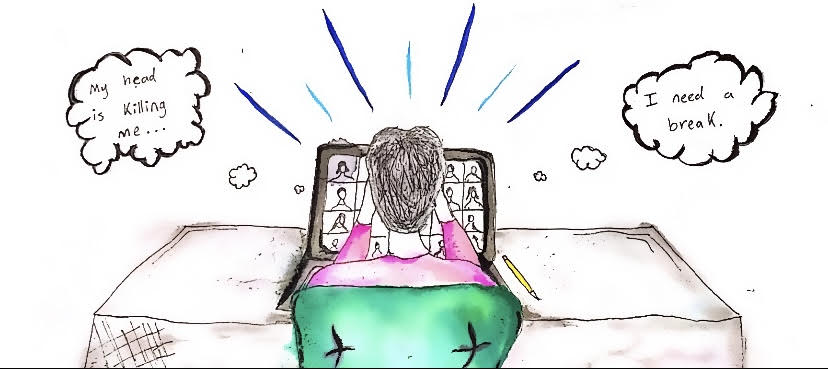Transition into hybrid schedule calls for less screen time
October 2, 2020
The natural routine of interacting with classmates, teachers and faculty in-person is long gone. For the start of the 2020-2021 school year, eyes glued to a screen on Zoom has become the new normal for District 225.
As South adjusted to e-learning last spring with no requirement of having Zoom sessions, Step 2 of District 225’s Learning and Operational Plan for the 2020-2021 School Year requires a daily structured block schedule on Zoom. When the Board of Education made the decision on Sept. 29 to move into Step 3, the hybrid model, the Glenbrook 225 administration created a new bell schedule.
Principal Dr. Lauren Fagel stated that the revised schedule decreased the length of each class from 90 minutes to 80 minutes and extended lunch to 95 minutes.
“[The extended lunch period was created] for students to have lunch, take a break, take a nap and get some other homework done,” Fagel stated.
Sophomore Kaylee Calito has endured the harmful effects of excessive screen time from e-learning, as it has urged her to purchase Blue Light glasses, which reduce exposure to blue light waves that trigger migraines from a computer screen.
“I’ve had [migraines] for a year, and with e-learning, it makes it a lot harder,” Calito said. “Even with these special glasses I have, I’m still super tired after the end of the day.”
In the previous bell schedule of a 90-minute block, many teachers gave students a small break during the required Zoom session. English Teacher Jen Jun makes it a point to give her students a five to ten-minute break during classes and has continued to do so with the new bell schedule. Jun has observed that it has made e-learning easier for students.
“Giving breaks allows for chunking out the lesson so everything is more digestible,” Jun explained. “[After students return from a break] they’re a lot more energized! When the videos and mics come back on, many return with smiles. I think the physical movement is refreshing and generally encourages everyone to be more focused.”
Senior Rebecca Thomas explained that while half of her classes give breaks, she finds it difficult to focus in the classes that do not give breaks.
“Having breaks in all of my classes would give me the chance to get up and at least walk around for a bit because the 10-minute ‘passing periods’ go by a lot quicker than it may seem,” Thomas stated.
With the shortened class time, The Oracle acknowledges that it may be more difficult for teachers to find time for a break. However, with an extended amount allocated towards lunch, the Editorial Board strongly encourages students to utilize that time off-screen in order to combat Zoom fatigue.
The Mayo Clinic reports that increased screen time can cause sleep problems, increase the risk of depression and increase the rates of obesity. They mention that the recommended recreational screen time is two hours. With classes on Zoom, the consequences of too much screen time have heightened. Furthermore, it is imperative that students take advantage of the breaks when able to do so.
English Teacher Dayna Cottrell emphasized the importance of prioritizing one’s well being amidst this year’s academic shift and thinks that taking time off-screen is crucial.
“I think in this District, we hold ourselves to a very high standard and I think we’re continuing to do that, but we also need to continue to consider the well-being of students,” Cottrell stated. “If students and staff aren’t well, if they’re not emotionally well, if they’re not physically well, then they’re not going to be successful in these other endeavors.”
Similarly, Thomas believes that it is a student’s responsibility to make the most out of their breaks.
“Sitting at the computer screen can be really straining for the eyes and just uncomfortable,” Thomas said. “[Students could use their breaks] by going outside of the room that they are in, getting a glass of water or just interacting with other people in the house!”



